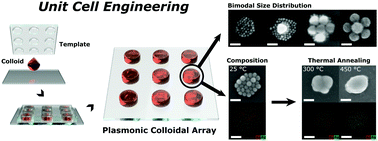Pre- and post-assembly modifications of colloidal plasmonic arrays: the effect of size distribution, composition and annealing†
Abstract
Templated self-assembly has emerged as one of the most versatile approaches for the fabrication of plasmonic ordered arrays composed of colloidal nanoparticle clusters, representing a valid alternative to top-down lithography for the scalable and low-cost production of this type of plasmonic substrates. Templated self-assembly can be applied to a variety of materials, solvents, and colloidal size, shape, and composition. A higher degree of control over the preparation of the colloids and their assembly would enable the rational modification of the internal composition and architecture of the repeating units of the array, targeting specific properties and applications. In this work, we explored both pre- and post-assembly modifications of the plasmonic system, analyzing their effect on the resulting collective optical properties. Combining both gold nanoparticles of different sizes and mixtures of gold and silver colloids, we demonstrated the possibility of leveraging near- and far-field coupling to control the optical losses of the system. Moreover, we explored the application of a thermal annealing step to induce the sintering of the colloidal building blocks within the plasmonic clusters. At lower temperatures (300 °C), the resulting single plasmonic objects are characterized by an inhomogeneous elemental distribution, while atomic migration and formation of alloys is triggered at higher temperatures (450 °C). By systematically analyzing the effect of the annealing we show an improvement in lattice plasmonic resonance quality factor of a gold nanoparticle array by 20%, without compromising its characteristic chemical and physical stability. Collectively, our results establish intriguing directions for the preparation of plasmonic arrays where the repeating unit can be engineered either before or after the assembly targeting specific catalytic, optical or magnetic properties.

- This article is part of the themed collection: Journal of Materials Chemistry C Emerging Investigators


 Please wait while we load your content...
Please wait while we load your content...